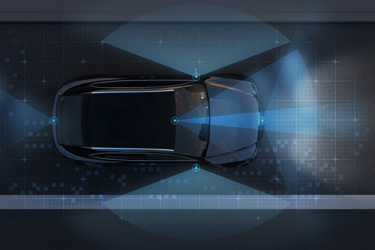Automotive LiDAR Revolution Rooted In Photonics

By Emily Newton

Photonics improves LiDAR by unlocking new levels of reliability and scalability for automotive technologies. In the early days of autonomous vehicles and advanced driver assistance systems (ADAS), mechanical spinning LiDAR sensors were the industry standard. Still, they came with major trade-offs in size, cost, and durability. Today, the automotive world is shifting toward solid-state, photonics-enabled systems.
These innovations deliver faster scanning speeds, sharper resolution, and longer life spans without the vulnerabilities of moving parts. This transition reshapes how vehicles perceive their surroundings, which enables real-time decision-making with greater accuracy and safety. As photonics technology matures, it enhances LiDAR performance and helps redefine what is possible in next-generation automotive design.
Challenges In Legacy LiDAR Systems
Traditional mechanical systems face several limitations that slow their adoption in mainstream automotive markets. High costs, fragile moving parts, and limited scalability make them less practical for widespread vehicle deployment compared to more mature technologies like cameras and radar. Unlike these established systems, LiDAR still depends on complex optical semiconductor technology, which drives manufacturing costs and slows production at scale.
Mechanical LiDAR units also struggle with performance gaps, offering shorter detection ranges, lower resolution, and slower response times — critical weaknesses in high-speed driving scenarios. Photonics addresses these challenges by replacing bulky mechanical components with chip-based solutions that improve range, resolution, and real-time responsiveness. It also makes mass production more viable for automotive-grade applications.
Photonics-Based Breakthroughs In LiDAR Architecture
Photonics improves LiDAR by reengineering its core architecture, making sensors faster, smaller, and far more reliable than their mechanical predecessors. Instead of relying on spinning mirrors or oscillating parts, today’s innovative systems leverage advances in engineering to streamline design and boost performance.
These breakthroughs shape the next generation of automotive LiDAR, which makes it better suited for the complex demands of autonomous driving and ADAS environments. Here are ways photonics transforms this technology:
- Photonic integrated circuits: Combine multiple optical functions onto a single chip, reducing size, cost, and power consumption.
- Coherent LiDAR and frequency-modulated continuous-wave approaches: Improve velocity detection and signal-to-noise ratios, offering superior object tracking and more accurate distance measurements.
- Silicon photonics: This allows high-volume, chip-scale manufacturing with precise beam control, which makes it easier to mass-produce compact and scalable LiDAR modules.
- Optical phased arrays: Eliminate mechanical beam steering by manipulating light electronically and supporting faster, programmable scanning patterns.
- On-chip signal processing: Integrate data acquisition and pre-processing directly onto photonic chips, reducing latency and enabling real-time scene interpretation.
Wavelength Innovation And Optical Safety Standards
Eye-safe operation is critical for LiDAR systems in automotive environments because vehicles must interact safely with people, other vehicles, and surrounding infrastructure. These sensors continuously communicate with cameras, GPS, and accelerometers to build a real-time picture of the environment. This collaboration allows autonomous cars to navigate efficiently without human intervention.
LiDAR systems must meet strict standards like the Class 1 laser safety classification to maintain safety while improving sensor performance. Compliance ensures emitted beams are harmless even during direct exposure. Photonics technology enables longer wavelengths, less damaging to human eyes, and offers deeper penetration into challenging conditions like fog, dust, or rain.
These wavelengths also enhance reflectivity from various surfaces, helping vehicles detect obstacles at greater distances with better accuracy. Integrating advanced photonic components expands the range and resolution of LiDAR sensors and enables safer, more reliable autonomous mobility.
Manufacturing Advantages And Scalability For OEMs
Photonics aligns closely with automotive production needs by offering easier, faster, and more cost-effective solutions to manufacture at scale. Many photonics-based LiDAR components are compatible with standard fabrication processes, which allows manufacturers to leverage existing semiconductor production lines without major retooling.
These systems also produce lower thermal and mechanical stress than traditional mechanical LiDAR, improving overall durability and performance under the harsh conditions vehicles often face. Because photonic systems are smaller, lighter, and more stable, they integrate more easily with existing automotive sensor stacks, streamlining design and assembly.
Reduced calibration requirements and enhanced long-term reliability further strengthen the case for photonics. These benefits provide automakers with a sensor solution that can maintain high performance over years of real-world use with minimal maintenance.
Collaborative R&D And Ecosystem Evolution
Cross-industry partnerships accelerate the development and deployment of photonics-based LiDAR systems for automotive use. Startups, Tier 1 suppliers, and foundries work together to bring advanced solutions to mass production, combining optics, semiconductors, and automotive engineering expertise. Research labs also push the boundaries by advancing materials science, helping create smaller, faster, and more efficient light-based circuits.
These innovations have boosted processing capabilities to levels that earlier generations of LiDAR could not have imagined. They allow vehicles to interpret their surroundings with stunning speed and accuracy. Industry groups also drive progress through new standards and interoperability initiatives, making it easier for manufacturers to integrate photonics-based LiDAR into diverse vehicle platforms and sensor suites without starting from scratch.
Shaping The Future Of Automotive Safety And Autonomy
Photonics improves LiDAR by boosting its performance and redefining its role as a cornerstone of automotive safety and autonomy. Continued investment in research and development is essential to unlock the potential of next-generation mobility. Closer collaboration between optics engineers and automotive system designers will ensure safer and more scalable solutions for the road ahead.
